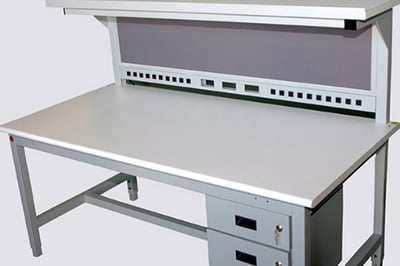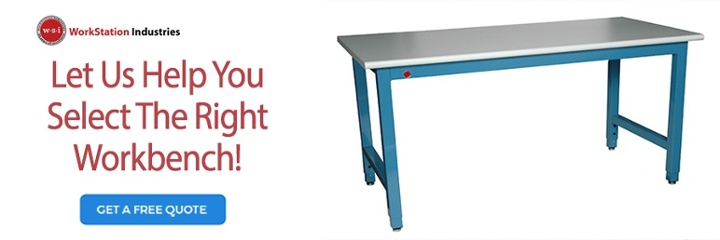Choosing the right workbench can be difficult, especially when you start seeing all the options and costs associated with them. It is important to really take a look at your needs before you buy industrial furniture like a heavy duty industrial workbench, or it could cost you more than you anticipate.
Let’s look at some of the factors you should consider:
- Weight load capacity
- Construction
- Workbench countertops
- Lift mechanism
- Workbench accessories
 Weight Load Capacity
Weight Load Capacity
Weight load capacity matters in both standard and heavy duty workbenches. A workbench is typically used as a surface for various types of work, from manufacturing to laboratory experiments.
These types of projects often involve the use of heavy materials, such as large tools and equipment that can be bulky. If a workbench does not have a sufficient weight load capacity, it may not be able to support the weight of these materials and tools, leading to instability and potentially dangerous conditions.
For example, a workbench with a low weight load capacity may bow or sag under the weight of heavy materials, causing the work surface to become uneven. This can lead to an unusable investment, or worse, accidents. Over time, repeated use and exposure to heavy loads may also cause the workbench to become damaged or weakened, potentially leading to the need for repairs or replacement.
When choosing your workbench, consider the weight load capacity that is appropriate for the types of projects and materials found in your laboratory or manufacturing space in order to ensure safety and durability.
Heavy Duty - Heavy duty benches will typically have a 5,000 lb. weight load capacity. If the workbench is 96” wide, the weight load capacity will usually go down to 4,000 lbs.
Extra Heavy Duty - Extra heavy duty workbenches will have between 10,000 lb. and 20,000 lb. weight load capacities.
Standard - Standard benches usually have 750 lb. to 1,000 lb. weight load capacities.
Workbench Construction
Choosing the appropriate level of construction for an industrial workbench is important because it ensures that the workbench can withstand the demands of the intended use.
Heavy Duty - Heavy duty construction typically means that the workbench is designed to withstand a high weight load capacity and frequent use in industrial settings. These workbenches are often made with heavy-gauge steel or other sturdy materials, and may have additional reinforcements to ensure stability and durability.
Extra Heavy Duty - Extra heavy duty construction takes durability a step further and is designed for even more demanding environments. Extra heavy duty benches are usually constructed with 12 gauge steel, all welded with 3” square legs for extra durability and strength. A lower shelf gives the bench added structural stability. They typically come with pre-punched floor mounting plates on the legs for additional stability.
Standard - Standard construction is typically designed for lighter use and less demanding applications. These workbenches may have a lower weight load capacity and may be made with lighter materials.
Typically constructed from 16 gauge steel, these benches are fully welded and have 2” square legs for durability and strength. They may have a lower shelf or foot rest bar. They usually come with floor leveling glides or optional casters.
Workbench Countertops
The countertop of an industrial workbench is important because it is one of the most used components of the workstation. Without the right work surface in place, chemicals, tools and more could damage it, rendering it unusable.
A countertop material should be durable, resistant to damage and wear, and able to withstand exposure to chemicals, heat and moisture, depending on the specific needs of the application.
Keep in mind that some materials are heavier than others, and the weight of the countertop material should be considered when choosing a heavy duty industrial workbench or a standard workbench.
There are numerous tops to choose from. Here are the most common:
Phenolic Resin: Typically used in labs, and are designed as one solid, lightweight countertop that is durable and long-lasting.
Epoxy Resin: Durable and non-porous, and holds up very well under harsh and extreme conditions such as high heat.
Solid Surface: Solid surface countertops are often made from acrylic or polyester resins and feature a filler material. They are non-porous and water-proof, and feature many different customizable looks.
Chemical Laminate: This countertop choice is budget friendly and is produced by layering melamine resin, layers of wood fibers and phenolic resin-impregnated Kraft paper with a decorative substrate. They are highly protective against chemical agents.
High Pressure Laminate: Used for basic, non-extreme applications. While they are functional and durable, they’re also very affordable.
ESD laminate: This material provides a safe work surface for environments where static electricity is a concern. As an added benefit, ESD laminate surfaces are also resistant to staining and chemicals that include acetone, gasoline and 10% ammonium solutions.
Stainless Steel: Resistant to bacteria, rust and corrosion. They also are stain and heat resistant. This makes stainless steel an ideal choice for laboratories where high heat and open flames are used.
Butcher Block: Traditionally used in woodworking and basic assembly applications. While this type of countertop is sturdy, it’s also porous and can dent easily. This type of material likely isn’t an appropriate choice for a laboratory workstation unless used in non-work areas or in labs where abrasive chemicals are not handled.
You can read more about the features and benefits of these lab countertops in our article, Top 5 Materials To Consider For Your Lab Countertops.
Lift Mechanism
Industrial workbenches can also be adjustable in height. This ergonomically-friendly design shortens or elongates the legs of the bench so that an employee can sit or stand at a supportive level. This feature allows employees of all sizes and heights to adjust the workbench to a more comfortable level while working.
There are typically four types of adjustable workbenches available:
- Slot adjustment
- Hand crank
- Hand crank with hydraulic features
- Electric
Slot Adjustment Bench
A slot adjustment bench allows a worker to make adjustments by raising the work bench legs and removing bolts or spacers. While employees can adjust the height of the bench, this design isn’t the most ergonomically-friendly option because it requires the worker to manually lift the bench.
Hand Crank Workbench
A hand crank adjustable height workbench is also manual in design, but allows employees to rotate a hand crank to lift or lower the bench. A hand crank makes the process easier for workers, but if there are heavy objects on the bench, it may be difficult to raise and lower the worksurface.
Hand Crank Workbench With Hydraulic Features
When cranked, the hand crank workbench with hydraulic features uses hydraulic fluid in the cylinders to force the shafts in the adjustable workbench legs to elevate. This pressure that lowers or lifts the work surface makes the process easier, especially with heavy duty workbenches that hold heavy loads.
Depending on the workbench you purchase, hydraulic adjustable versions can lift up to 1,000 pounds. If you are selecting heavy duty workbenches because of their weight load capacity, you may benefit from an adjustable workbench with hydraulic features or an electric workbench (which we’ll explore below) since they are easier for an employee to lift.
Electric Workbench
An electric adjustable height workbench provides the highest level of ergonomic support because an employee can lift or lower the surface with the simple push of a button. If there are heavy work tools on the bench, a bench with an electrical component will also require less physical effort to raise the bench than hand cranking the bench.
Depending on the model, you may be able to preset positions for convenience as well. This can come in handy if multiple workers use the same bench in multi-shift operations. However, electric workbenches are often among the most expensive to buy. Yet this type can also typically handle higher weight capacities, and you don’t have to worry about oil leaks that may come with hydraulic benches over time with heavy use.
Workbench Accessories
Whether you’re selecting a heavy duty industrial workbench or a standard workbench, it’s a good idea to consider the add-on items that make the most sense for both your workspace and the workbench itself.
Some examples of accessories that increase the functionality of the space while improving storage and organization include:
Utility Drawers - Drawers come in a variety of sizes and configurations.
Shelves - Shelves can be used below or above the worksurface; Steel, laminate and wire are usually offered.
Upper Cabinets - These are usually cabinets with flipper doors for storage.
Footrests - Footrests come in the form of a horizontal bar, an ergonomic pan that attaches to the horizontal bar or a freestanding foot rest.
Electrical Power Strips - These usually mount to the worksurface or uprights.
Utility Options - Utility ductway for data, air and gas that is usually attached to the upright.
Lighting - Overhead LED lighting can brighten a space without having to add more light fixtures.
Articulating Monitor Arms - Fully articulating arms are available to accommodate flat screens and laptops.
Keyboard Trays - Keyboard trays can be added to any worksurface or articulating arm.
CPU Holders - Fixed or adjustable CPU holders can be added to benches to secure your electronics.
Pegboards - Metal pegboards can be added between the uprights to attach tools.
Bin Rails or Panels - Bin rails or panels can be attached to the uprights and holds plastic bins for storage of parts and accessories.
ESD Grounding Kits - This allows for grounding of the bench for those that have ESD requirements.
Cost Heavy Duty Work Benches Vs. Standard Work Benches
There is a definite cost difference between standard, heavy duty and extra heavy duty benches. One average, you will pay 50% or more for a heavy duty bench, as opposed to a standard bench.
When going to an extra heavy duty bench, you will pay an additional 50% or more to the price of the heavy duty bench.
Which tabletop material and any additional accessories you choose can impact your final purchase price as well. Working with reputable industrial workbench manufacturers can help to ensure your final workbench design not only meets your needs, but falls within your established budget as well.
A high-quality industrial furniture company will work with you to customize a plan based on these needs, as well as ensure you receive your final product in a timely manner so you do not experience any production delays.



